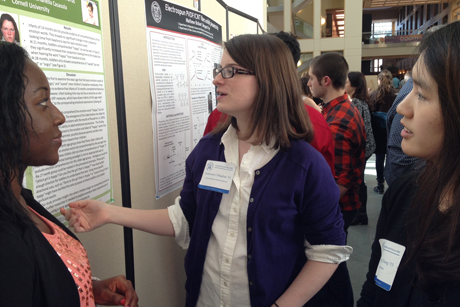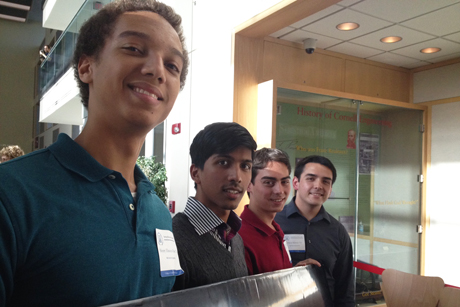By Blaine Friedlander
Reprinted from Cornell Chronicle, April 18, 2013

Left, Gloria Appiah-Kubi ’13 talks with Katherine Callaghan ’14, center, and Hyun Jung Chung ’13 at the Cornell Undergraduate Research Forum April 17. Appiah-Kubi and Callaghan explained their study about children who recognize emotion words. Chung discussed problematic vaccination policies. Photo by Blaine Friedlander/Cornell Chronicle
From atmospheric pressures to zoological inquiries, about 140 undergraduates put posters of their projects on display at the 28th Annual Spring Research Forum at Duffield Hall.
Showing their scientific savvy, the students engaged in full-scale research projects, under the guidance of faculty members. At the forum, the students shared their work and engaged with several faculty and their own peers. Here are some scientific samples:
•Meet Katherine Callaghan ’14, Gloria Appiah-Kubi ’13 and Madhuri Martin ’13, who studied young children to discern when they comprehended emotion words. They found that by 21 months, toddlers could understand the term “happy,” and by 28 months these little humans seem to understand “scared.”
•Does parenting matter? It does to Marie Camerota ’13, who researched young children to explore the link among poverty, mental state language and executive function in infancy. She found that when mothers used descriptive words about a mental state such as “think,” “remember,” “want,” and “hope” with babies and toddlers, the child’s executive function – mental tasks like organizing, planning and paying attention – became very good.

From left, Henry Ekwaro-Osire ’14, Nikhil Lal ’14, Peter Ingato ’14 and Oliver Kliewe ’14 hold up the wing portion of their wingmill harvester – an oscillating system that captures energy – at the Cornell Undergraduate Research Forum April 17. Photo by Blaine Friedlander/Cornell Chronicle
•Andrea Fortman ’13 captured a rainfall of raw research when she examined storm water retention basins near parking lots. Fortman found many such basins work poorly, in that they don’t filter water properly.
•Walking along natural gas pipelines in Pennsylvania, Cassandra Garcia ’13 sought to learn the effects of human projects on amphibians. Huge swaths of forest get permanently sawed down to give way to the energy pipelines. In fact, Garcia found that the prevalent redbacked salamander rarely ventures near the pipelines in the hot summer sun, and they scurry to find cover, preferring the cool comfort of forests and wood piles.
•Michael Kaplan ’13, in seeking to build a better democracy, created an electronic, Web-based “argument map” to develop community knowledge formation. It shows articulated, constructive arguments on public issues for which people may or may not agree. Users at Kaplan’s thepublicspheres.com can contribute, organize and vote on arguments.
•Elizabeth McDonald ’13, who works in the Cornell Lab of Ornithology, described the differing sounds of sperm whales. Using resonances captured from the Gulf of Mexico, McDonald employed sound software analysis and explained at the forum the calls of the whales.
•Examining the secondary structures of influenza virus RNA, Ray Zhuang ’15 aimed to see how its eight segments interact, with an eye toward helping science knock out the flu.
•Describing the new world of wingmill energy harvesting, Oliver Kliewe ‘14, Nikhil Lal ’14, Peter Ingato ’14, Henry Ekwaro-Osire ’14, Yan Asta Li ’16 and Al Jean-Francois ’13 showed their harvester to demonstrate the feasibility of capturing low velocity, turbulent airflow using an oscillating wing system that could be used on the ground or a rooftop. Looking toward sustainability, they hope they’ve found a next-generation power source.
•Chima Amadi ’15 examined the biological effect of plasma, with an eye toward regenerating tissue and other medical uses.
The forum was organized by the student-run Cornell Undergraduate Research Board and co-sponsored by the Office of the Vice Provost for Undergraduate Education and the Office of Undergraduate Research. ##
Twenty-one of the CURB presentations involved undergraduates or faculty from the Department of Human Development, comprising the majority of the presentations from the College of Human Ecology. Click here for a list of the HD presentations.

